1899, Philippines: Through the Treaty of Paris (1898), Spain gives control of the Philippines to the United States for $20 million. The Filipino-American War begins shortly after. Known in U.S. history books as the "Philippine Insurrection", it was America's first true overseas war, lasting from 1898 to 1902. In those 3 years, as many as 70,000 Americans die, along with close to 2 million Filipinos.
1914, Mexico: Mexican officials detain several drunken U.S. Marines from the U.S.S. Dolphin, which is docked in the port of Tampico, Mexico, after they accidentally enter a restricted area. The Mexican government quickly releases them, and issues an apology. Regardless of the regret expressed by Mexican President Victor Huerta, U.S. Admiral Henry T. Mayo demands that Mexican troops salute an American flag as a sign of contrition. President Huerta refuses the salute; three days later, President Wilson orders American warships to Tampico Bay. Wilson insists that his anger is not directed at the Mexican people, but at Huerta, "and those who adhere to him" because he refused to salute the American flag as an official apology. By the end of 1914, U.S. Marines had seized Tampico, forced an apology from Huerta, and demanded his resignation from power. Tampico, Mexico was considered the world's largest oil port in 1901. Some of the richest oil fields were discovered within a 100-mile radius of the port between 1914-1918.
1914, Europe: United States claims to be neutral as Germany, France, and Britain engage in conflict; however, U.S. banks and weapons manufacturers continue selling to France and Britain, leading to the German sinking of the ship, Lusitania, and eventual U.S. entry to World War 1.
1945, Japan: The United States becomes the first country to use atomic weapons in warfare, killing thousands of Japanese civilians in the cities of Hiroshima and Nagasaki. Concluded the United States Strategic Bombing Survey of 1946, "air supremacy over Japan could have exerted sufficient pressure to bring about unconditional surrender and obviate the need for invasion. Based on a detailed investigation of all the facts, and supported by the testimony of the surviving Japanese leaders involved, it is the Survey's opinion that ... Japan would have surrendered even if the atomic bombs had not been dropped, even if Russia had not entered the war and even if no invasion had been planned or contemplated."
1950, Korea: Without the approval of Congress, President Harry Truman sends troops to fight in Korea, asserting an inherent right to do so as Commander-in-Chief. The Korean War ends three years later, leaving behind 33,600 American casualties, 16,000 UN-allied, 415,000 South Korean, 520,000 North Korean, and an estimated 900,000 Chinese.
1953, Iran: British intelligence agencies join with the C.I.A. to overthrow the Iranian government out of fears it will nationalize oil production.
1954, Guatemala: Jacobo Árbenz Guzmán, the democratically-elected President of Guatemala, issues land reforms which threaten the interests of U.S.-based United Fruit Company. C.I.A. Director Allen Dules, along with his brother, both have stakes in the company. It heavily lobbies the U.S. government to take action. Shortly after, the C.I.A. begins training rebels, and sets up a radio station across the border led by fake rebels to instigate a revolution. Eventually, the Guatemalan President is sent into exile.
1961, Iraq: Abdel Karim Kassem, leader of Iraq, threatens western oil interests, causing the U.S. and Britain to begin arming Kurdish rebels in the country. In 1963, Kassem is forced out of power, put on trial, and eventually shot to death. By 1968, Saddam Hussein takes power in the country, backed by the C.I.A.
1964, Vietnam: The USS Maddox is gathering intelligence off the coast of North Vietnam when a group of North Vietnamese torpedo boats approach the ship. The Maddox opens fire, the North Vietnamese respond with torpedoes, but they are eventually driven away. The exchange prompts the US government and news media to report that North Vietnamese torpedo boats launched an "unprovoked attack" against the Maddox while it was on a "routine patrol".
Two days later, Captain John J. Herrick of the USS Maddox sees two "mysterious dots" on his radar screen, determines they are torpedo boats, and sends an emergency cable to headquarters in Honolulu reporting that the ship is under attack. Shortly after, Herrick sends another cable: "Freak weather effects on radar and over eager sonar men ... No actual visual sightings by Maddox. Suggest complete evaluation before any further action taken." Less than an hour later, Herrick sends a third cable, saying he is now uncertain of what had happened; however, by this time, President Johnson is already announcing a major military escalation in Vietnam.
By the end of the Vietnam War, millions of Vietnamese civilians have perished, along with more than 50,000 U.S. soldiers.
1970, Cambodia: President Richard Nixon announces that U.S. troops are invading Cambodia, the country west of Vietnam through which the North Vietnamese are allegedly supplying their troops. For more than a year prior to the announcement, the U.S. had been conducting bombing raids in the country.
1982, Iraq: U.S. backs Iraq against Iran, supplying Saddam Hussein with intelligence, diplomatic aid, and chemical weapons (which would later be used to massacre innocent people).
1990, Iraq: In August, U.S. fighter jets, aircraft carriers, battleships, and half a million American troops are deployed to Saudi Arabia to defend against a possible attack from Iraq. Between its own oil fields, and those of Kuwait and Saudi Arabia, western governments allegedly fear Iraq could gain control over the majority of the world's oil reserves. Dick Cheney secures the U.S.-Saudi occupation agreement, ensuring there will be no set withdrawal date from Saudi Arabia, thereby allowing U.S. forces to remain.
In 1989, it was revealed in a leaked memo that C.I.A. officials were collaborating with Kuwaiti officials in an effort to take advantage of the "deteriorating" economic situation in Iraq.
Iraqi leader Saddam Hussein eventually annexes Kuwait, triggering the first Iraq War.
Kuwait had been part of the Ottoman Empire province of Basra, and included much of modern-day Iraq. Up until that point, Iraq had not recognized Kuwait's sovereignty, and the border between Iraq and Kuwait had never been clearly defined.
The US ambassador to Iraq, April Glaspie, claims that when she gave Iraq indications that the US would not oppose an invasion of Kuwait, she did not expect Iraq to take "all of Kuwait".
1999, Yugoslavia: U.S.-NATO bombs drop over the country allegedly to prevent a "massacre", though this claim is challenged. More than 2,000 civilians are killed. There are indications that basic infrastructure is deliberately targeted during this campaign. For example, a statement by Lt. Gen. Michael Short, US Air Force, quoted in the Washington Post, May 1999, reads: "If you wake up in the morning and you have no power to your house and no gas to your stove and the bridge you take to work is down and will be lying in the Danube for the next 20 years, I think you begin to ask, ‘Hey, Slobo, what’s this all about? How much more of this do we have to withstand?’ And at some point, you make the transition from applauding Serb machismo against the world to thinking what your country is going to look like if this continues."
October 2001. Afghanistan: The United States begins bombing Afghanistan. Estimates suggest that nearly 8,000 civilians will be slaughtered by U.S. attacks during the first year of the invasion (for some perspective, that's a casualty rate which is three times higher than the 9/11 attacks [3,000 deaths] in less than a year's time).
October 26, 2001: The Patriot Act is signed by George W. Bush, laying the foundation for "a domestic intelligence-gathering system of unprecedented scale and technological prowess", according to The Washington Post. Warned the United States Commission on Civil Rights, the Patriot Act "risks establishing a new generation of racial profiling in which a person’s ethnicity or national origin significantly increases his or her chance of being scrutinized by local law enforcement or detained at an airport".
2003. Iraq: 250,000 U.S. forces augmented by 45,000 British troops and small contingents from Poland, Australia, and Denmark begin attacking Iraq. The invasion ultimately results in 3,000 U.S. military deaths, and, according to Wikileaks, more than 50,000 Iraqi civilian deaths.
October 2007: U.S. General Wesley Clark gives a speech to the Commonwealth Club in San Francisco in which he denounces what he calls "a policy coup" engineered by neocons. Clark says that after 9/11 he was told about a Pentagon plan to attack not only Iraq, but also Syria, Lebanon, Libya, Somalia, Sudan and Iran, over the course of five years.
February 2009: President Barack Obama, in his first major military decision, authorizes the Pentagon to send an extra 17,000 troops to Afghanistan. This "surge" is supported by Bush-era neocons Bill Kristol, Robert Kagan, and Dan Senor.
December 17, 2009. Yemen: U.S. cruise missiles are fired at what officials in Washington claim are al-Qaeda training camps in Yemen, killing over 60 civilians, 28 of them children.
February 2010: Obama accelerates the Bush-era aerial drone program. An exposé in the New York Times reveals that the Obama Administration considers "all military-age males [killed] in a strike zone" to be "combatants ... unless there is explicit intelligence posthumously proving them innocent."
Summer 2010. Iran: The Obama Administration launches a wave of cyber attacks against Iranian nuclear facilities, attacks which are by the Pentagon's own definition an act of warfare.
August 2010. Pakistan: A U.S. drone in Pakistan kills 20 people, "with at least four women and three children among the slain". At least 13 other civilians are also reported wounded, including a number of other children. Drone strikes still continue to kill more and more civilians.
2011. Libya: The U.S. participates in the bombing of Libya to overthrow Libyan President Muammar Gaddafi, slaughtering dozens of civilians in the process.
May 2011. Libya: Just hours before the announcement that Osama Bin Laden had been killed in Pakistan, Saif al-Arab, 29, and three of Libyan leader Muammar Gaddafi's grandchildren, all reported to be under 12, are butchered by NATO/U.S. bombs in Libya.
October 2011. Yemen: Two U.S. citizens are executed without trial by U.S. drones in Yemen: one is Anwar al-Awlaki, allegedly linked with al-Qaeda; the other U.S. citizen is Abdulrahman al-Awlaki, the 16-year-old son of Anwar.
October 2011. Uganda: Obama will deploy U.S. forces to oil-rich Uganda.
August 2012, Guatemala: Obama deploys U.S. Marines to Guatemala to "help fight the drug war".
September 2012. Libya and Yemen: Obama announces the deployment of U.S. troops to both Libya and Yemen.
September 2012. Iraq: According to the New York Times, a unit of U.S. Army Special Operations soldiers are deployed to Iraq and more U.S. soldiers may soon be on their way.
October 2012. Jordan: The U.S. sends a "task force" of more than 150 "planners and other specialists" to Jordan.
U.S. troops arrive in Turkey
http://www.cnn.com/2013/
 |
| U.S. soldiers during the Philippine–American war |
1914, Mexico: Mexican officials detain several drunken U.S. Marines from the U.S.S. Dolphin, which is docked in the port of Tampico, Mexico, after they accidentally enter a restricted area. The Mexican government quickly releases them, and issues an apology. Regardless of the regret expressed by Mexican President Victor Huerta, U.S. Admiral Henry T. Mayo demands that Mexican troops salute an American flag as a sign of contrition. President Huerta refuses the salute; three days later, President Wilson orders American warships to Tampico Bay. Wilson insists that his anger is not directed at the Mexican people, but at Huerta, "and those who adhere to him" because he refused to salute the American flag as an official apology. By the end of 1914, U.S. Marines had seized Tampico, forced an apology from Huerta, and demanded his resignation from power. Tampico, Mexico was considered the world's largest oil port in 1901. Some of the richest oil fields were discovered within a 100-mile radius of the port between 1914-1918.
 |
| U.S. battleships steaming toward Veracruz following the Tampico Affair |
1914, Europe: United States claims to be neutral as Germany, France, and Britain engage in conflict; however, U.S. banks and weapons manufacturers continue selling to France and Britain, leading to the German sinking of the ship, Lusitania, and eventual U.S. entry to World War 1.
1945, Japan: The United States becomes the first country to use atomic weapons in warfare, killing thousands of Japanese civilians in the cities of Hiroshima and Nagasaki. Concluded the United States Strategic Bombing Survey of 1946, "air supremacy over Japan could have exerted sufficient pressure to bring about unconditional surrender and obviate the need for invasion. Based on a detailed investigation of all the facts, and supported by the testimony of the surviving Japanese leaders involved, it is the Survey's opinion that ... Japan would have surrendered even if the atomic bombs had not been dropped, even if Russia had not entered the war and even if no invasion had been planned or contemplated."
 |
| Atomic bomb mushroom clouds over Hiroshima (left) and Nagasaki (right) |
1950, Korea: Without the approval of Congress, President Harry Truman sends troops to fight in Korea, asserting an inherent right to do so as Commander-in-Chief. The Korean War ends three years later, leaving behind 33,600 American casualties, 16,000 UN-allied, 415,000 South Korean, 520,000 North Korean, and an estimated 900,000 Chinese.
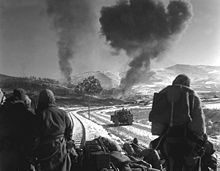 |
| U.S. Marines fighting Chinese forces, December 1950. |
1953, Iran: British intelligence agencies join with the C.I.A. to overthrow the Iranian government out of fears it will nationalize oil production.
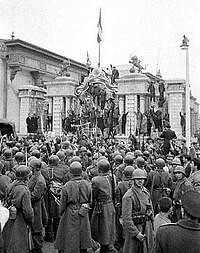 |
| Iranian soldiers surround the parliament building in Tehran |
1954, Guatemala: Jacobo Árbenz Guzmán, the democratically-elected President of Guatemala, issues land reforms which threaten the interests of U.S.-based United Fruit Company. C.I.A. Director Allen Dules, along with his brother, both have stakes in the company. It heavily lobbies the U.S. government to take action. Shortly after, the C.I.A. begins training rebels, and sets up a radio station across the border led by fake rebels to instigate a revolution. Eventually, the Guatemalan President is sent into exile.
 |
| Operation PBSUCCESS: the deposed Guatemalan President Jacobo Árbenz Guzmán (1951–54) |
1961, Iraq: Abdel Karim Kassem, leader of Iraq, threatens western oil interests, causing the U.S. and Britain to begin arming Kurdish rebels in the country. In 1963, Kassem is forced out of power, put on trial, and eventually shot to death. By 1968, Saddam Hussein takes power in the country, backed by the C.I.A.
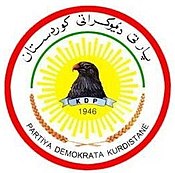 |
| Kurdistan Democratic Party |
1964, Vietnam: The USS Maddox is gathering intelligence off the coast of North Vietnam when a group of North Vietnamese torpedo boats approach the ship. The Maddox opens fire, the North Vietnamese respond with torpedoes, but they are eventually driven away. The exchange prompts the US government and news media to report that North Vietnamese torpedo boats launched an "unprovoked attack" against the Maddox while it was on a "routine patrol".
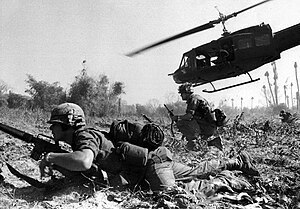 |
| US Soldier in Vietnam war |
By the end of the Vietnam War, millions of Vietnamese civilians have perished, along with more than 50,000 U.S. soldiers.
1970, Cambodia: President Richard Nixon announces that U.S. troops are invading Cambodia, the country west of Vietnam through which the North Vietnamese are allegedly supplying their troops. For more than a year prior to the announcement, the U.S. had been conducting bombing raids in the country.
 |
| 30 April 1970, President Nixon announced the attack into Cambodia |
1982, Iraq: U.S. backs Iraq against Iran, supplying Saddam Hussein with intelligence, diplomatic aid, and chemical weapons (which would later be used to massacre innocent people).
 |
| Victims of Iran-Iraq war |
1990, Iraq: In August, U.S. fighter jets, aircraft carriers, battleships, and half a million American troops are deployed to Saudi Arabia to defend against a possible attack from Iraq. Between its own oil fields, and those of Kuwait and Saudi Arabia, western governments allegedly fear Iraq could gain control over the majority of the world's oil reserves. Dick Cheney secures the U.S.-Saudi occupation agreement, ensuring there will be no set withdrawal date from Saudi Arabia, thereby allowing U.S. forces to remain.
In 1989, it was revealed in a leaked memo that C.I.A. officials were collaborating with Kuwaiti officials in an effort to take advantage of the "deteriorating" economic situation in Iraq.
 |
| F-15Es parked during Operation Desert Shield. |
Kuwait had been part of the Ottoman Empire province of Basra, and included much of modern-day Iraq. Up until that point, Iraq had not recognized Kuwait's sovereignty, and the border between Iraq and Kuwait had never been clearly defined.
The US ambassador to Iraq, April Glaspie, claims that when she gave Iraq indications that the US would not oppose an invasion of Kuwait, she did not expect Iraq to take "all of Kuwait".
1999, Yugoslavia: U.S.-NATO bombs drop over the country allegedly to prevent a "massacre", though this claim is challenged. More than 2,000 civilians are killed. There are indications that basic infrastructure is deliberately targeted during this campaign. For example, a statement by Lt. Gen. Michael Short, US Air Force, quoted in the Washington Post, May 1999, reads: "If you wake up in the morning and you have no power to your house and no gas to your stove and the bridge you take to work is down and will be lying in the Danube for the next 20 years, I think you begin to ask, ‘Hey, Slobo, what’s this all about? How much more of this do we have to withstand?’ And at some point, you make the transition from applauding Serb machismo against the world to thinking what your country is going to look like if this continues."
 |
| A street in Belgrade bombed by NATO |
October 2001. Afghanistan: The United States begins bombing Afghanistan. Estimates suggest that nearly 8,000 civilians will be slaughtered by U.S. attacks during the first year of the invasion (for some perspective, that's a casualty rate which is three times higher than the 9/11 attacks [3,000 deaths] in less than a year's time).
 |
| US marines in Afghanistan |
October 26, 2001: The Patriot Act is signed by George W. Bush, laying the foundation for "a domestic intelligence-gathering system of unprecedented scale and technological prowess", according to The Washington Post. Warned the United States Commission on Civil Rights, the Patriot Act "risks establishing a new generation of racial profiling in which a person’s ethnicity or national origin significantly increases his or her chance of being scrutinized by local law enforcement or detained at an airport".
2003. Iraq: 250,000 U.S. forces augmented by 45,000 British troops and small contingents from Poland, Australia, and Denmark begin attacking Iraq. The invasion ultimately results in 3,000 U.S. military deaths, and, according to Wikileaks, more than 50,000 Iraqi civilian deaths.
October 2007: U.S. General Wesley Clark gives a speech to the Commonwealth Club in San Francisco in which he denounces what he calls "a policy coup" engineered by neocons. Clark says that after 9/11 he was told about a Pentagon plan to attack not only Iraq, but also Syria, Lebanon, Libya, Somalia, Sudan and Iran, over the course of five years.
February 2009: President Barack Obama, in his first major military decision, authorizes the Pentagon to send an extra 17,000 troops to Afghanistan. This "surge" is supported by Bush-era neocons Bill Kristol, Robert Kagan, and Dan Senor.
December 17, 2009. Yemen: U.S. cruise missiles are fired at what officials in Washington claim are al-Qaeda training camps in Yemen, killing over 60 civilians, 28 of them children.
February 2010: Obama accelerates the Bush-era aerial drone program. An exposé in the New York Times reveals that the Obama Administration considers "all military-age males [killed] in a strike zone" to be "combatants ... unless there is explicit intelligence posthumously proving them innocent."
Summer 2010. Iran: The Obama Administration launches a wave of cyber attacks against Iranian nuclear facilities, attacks which are by the Pentagon's own definition an act of warfare.
August 2010. Pakistan: A U.S. drone in Pakistan kills 20 people, "with at least four women and three children among the slain". At least 13 other civilians are also reported wounded, including a number of other children. Drone strikes still continue to kill more and more civilians.
 |
| Victims of US drone strikes in Pakistan |
2011. Libya: The U.S. participates in the bombing of Libya to overthrow Libyan President Muammar Gaddafi, slaughtering dozens of civilians in the process.
.jpg/220px-First_demonstrations_calling_for_toppling_the_regime_in_Libya_(Bayda,_Libya,_2011-02-16).jpg) |
| Destruction caused by NATO backed rebels in Libya |
May 2011. Libya: Just hours before the announcement that Osama Bin Laden had been killed in Pakistan, Saif al-Arab, 29, and three of Libyan leader Muammar Gaddafi's grandchildren, all reported to be under 12, are butchered by NATO/U.S. bombs in Libya.
October 2011. Yemen: Two U.S. citizens are executed without trial by U.S. drones in Yemen: one is Anwar al-Awlaki, allegedly linked with al-Qaeda; the other U.S. citizen is Abdulrahman al-Awlaki, the 16-year-old son of Anwar.
October 2011. Uganda: Obama will deploy U.S. forces to oil-rich Uganda.
August 2012, Guatemala: Obama deploys U.S. Marines to Guatemala to "help fight the drug war".
September 2012. Libya and Yemen: Obama announces the deployment of U.S. troops to both Libya and Yemen.
September 2012. Iraq: According to the New York Times, a unit of U.S. Army Special Operations soldiers are deployed to Iraq and more U.S. soldiers may soon be on their way.
October 2012. Jordan: The U.S. sends a "task force" of more than 150 "planners and other specialists" to Jordan.
U.S. troops arrive in Turkey
http://www.cnn.com/2013/

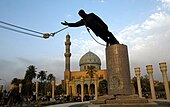
No comments:
Post a Comment